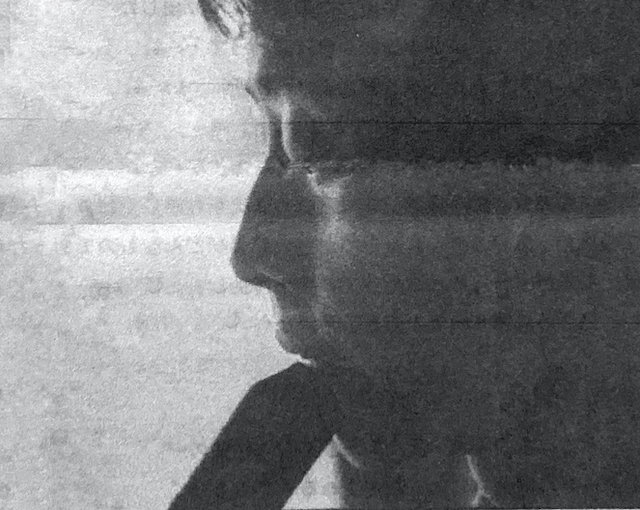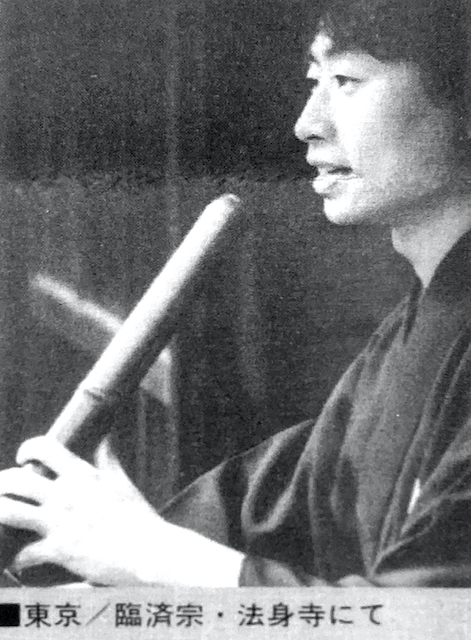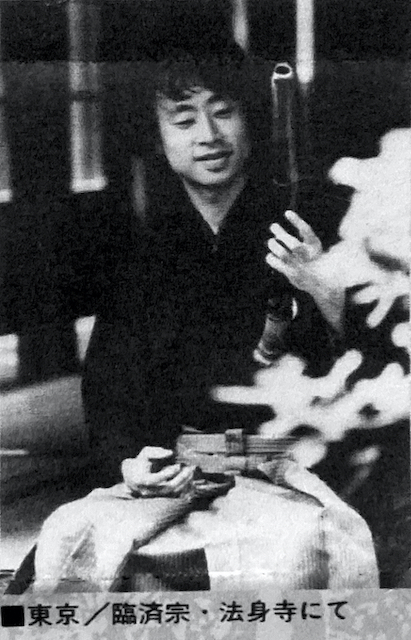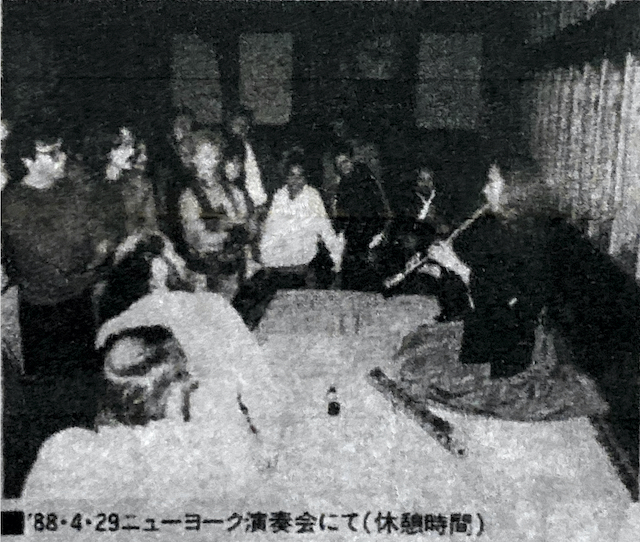Shakuhachi Classic No.5
1987/11/18

01 Garyoken takeshirabe
02 Chikugo sashi
03 Neri sashi
04 Takahe sashi
05 Uta renbo
06 Koro suga gaki
07 Yamato choshi
08 Takane takeshirabe
09 Azusa no Kyoku
10 Shiomotsuke no kyoku
11 Futaiken reibo
Shakuhachi Classic No.5 KUMO-I
Player: Takashi Tokuyama
Duration: 60 minutes
Recording: 1987/11 / 12,13
Shakuhachi Classic Tokuyama Group
Copyright C 2019 by Takashi Tokuyama
01 Garyoken takeshirabe (5:28)
02 Chikugo sashi (5:14)
03 Neri sashi(3:22)
04 Takahe sashi(5:03)
05 Uta renbo(3:12)
06 Koro suga gaki(6:38)
07 Yamato choshi(3:00)
08 Takane takeshirabe(3:08)
09 Azusa no Kyoku(5:11)
10 Shiomotsuke no kyoku(6:11)
11 Futaiken reibo(12:28)
This recording was recorded at a villa in the suburbs of Atami from midnight on November 12, 1987 to dawn on March 13. While riding in the recording staff's car, breathing in Ehime's 8 inch tunes and terrestrial songs (i.e. Kagetsu 8 inch borrowed from Aichi Inagaki for recording) I went to the mountain villa while putting. Soon after the setting was completed and recording started smoothly, it started to rain and I had to interrupt it. Although it is planned to be next, it will not stand. When I was waiting for a prayer, it soon rained and I was able to play again. I wanted to make two copies if possible in the recording over 5 hours, but I carefully selected them from the time and composition of the songs and put them together in the fifth volume. The rest of the sect of Nishiki-style is also finished, so please look forward to it after the sixth volume. As with the previous volume, this one volume alone was designed so that the entire picture of the shakuhachi classic can be seen. Up to this volume, we have used one shakuhachi 8 inch tuning, but in the future we plan to record even a long wall with no ground.
Shakuhachi Classic No.4
1985/12/25

01 hahi gaeshi (3:48)
02 sagari ha (3:38)
03 futaiken san ya(9:57)
04 shin no kyorei(13:29)
05 shinporyu hachi gaeshi(2:52)
06 hokkoku hachigaeshi(3:39)
07 echigo meianji hachigaeshi(4:47)
08 oshu reibo(6:18)
09 tsuruno sugomori(11:11)
Shakuhachi Classic No.4 DOH
Performer: Takashi Tokuyama
Duration: 60 minutes
Recording: 1984/10/12, 10/25
Mixing engineer: Kazuo Matsuzaki
Copyright C 2019 by Takashi Tokuyama
01 hahi gaeshi (3:48)
02 sagari ha (3:38)
03 futaiken san ya(9:57)
04 shin no kyorei(13:29)
05 shinporyu hachi gaeshi(2:52)
06 hokkoku hachigaeshi(3:39)
07 echigo meianji hachigaeshi(4:47)
08 oshu reibo(6:18)
09 tsuruno sugomori(11:11)
Volume 4, which was a difficult birth, was finally completed. Side A from October 12, 1985, Togakushi Village, Togakushi Folk Museum, Togakushi Daiwa Shakuhachi no Eve, and Side B, October 25, Tokyo Ushigome Hoshinji “Fukizen and Zazen Evening” Live recording from. A group called “Bamboo / Sound / Ki” that regularly offers a party to listen to brown rice vegetarian food and Fukuzen shakuhachi from acquaintances at iBD seminars that I have been deeply involved in. I used to play the shakuhachi only once in a place where iBD is a seminar that “knows its own value”. At that time, I listened to it, and later Sayaka Sasaki, who became a member of bamboo, sound, and ki, worked with an acquaintance Ryuhei Satono (runs the lodge "Tanne" at Togakushi),
and the shakuhachi meeting at Togakushi was realized. did. Mr. Satono presided over a concert centering on classical music at his lodge, and also visited the Fuzen-kai at the Hoshinji Temple in Tokyo, where he listened to my classical music. In the Asahi Shimbun the day after the meeting, “Togakushi Cram School” consisting of ten people from Minshuku ’s representatives, including a guest house and a ceramic artist, called on the shakuhachi. It was introduced with photos that the meeting was planned.

Shakuhachi Classic No.3
1985/8/31
01 mukaiji (20:49)
02 yoshiya (7:52)
03 o-tai(2:11)
04 san ya(8:56)
05 kumoi jishi(9:07)
06 hokkoku reibo(6:37)
07 aji kan(5:21)
Shakuhachi Classic No.3 SUYO
Player: Tokuyama Takashi
Duration: 60 minutes
Recording: 1984/11/17, 1985/8/3
Mixing: Kazuo Matsuzaki
Honkyoku Kenkyu Kai
Copyright C 2019 by Takashi Tokuyama
01 mukaiji (20:49)
02 yoshiya (7:52)
03 o-tai(2:11)
04 san ya(8:56)
05 kumoi jishi(9:07)
06 hokkoku reibo(6:37)
07 aji kan(5:21)

Here is the third volume. Live recording is finally here. In Tokyo Ushigome HOSSHINJI, we open “Fukizen Shakubachi no Eve”, where the student blows through this song, with Daizen Obuchi resident zazen teaching in between. "Mukaji" has been recorded since the 10th of August 3, 1985. Hoshinji is a Rinzai Buddhist temple, and since the Edo period, it has been the main head of the Punka Shakuhachi (classical main song), the Ome Reiho-ji Bodoji Temple. Saving.
At the meeting in August, Mr. Kosuge said, “Shakuhachi as HOUKI values the simplicity and pure tone, and it is better to talk to the self and the listener's Buddhist character—the clean heart that is born”. Then, after the participants took the form of zazen, he went to Fukizen (Kurumi) and led to INKIN (bell). I am enlightened by the story and remember that I was in a stable and deep blown zen. In the middle of the summer, along with the sound of a housewife in the neighborhood watering from the window on the second floor, it is accompanied with fun. The shakuhachi classical music is a valuable cultural heritage in Japan as an independent pure instrumental music that is not an accompaniment of songs or other types of performing arts, or as Buddhist music. Aiming at the preservation of historical materials and the reconstruction of the generalized shakuhachi road, today, the “Non Monk Society” has been established beyond the school. Please gather. Ninja Research Group, 3-82 Haramachi, Shinjuku-ku, 162
Shakuhachi Classic No.2
1984/11/16

01 kyorei (11:41)
02 takiochi (11:35)
03 murasakino no kyoku(11:35)
04 sankara sugagaki(4:33)
05 hirable sagariha(4:06)
06 tamake(5:42)
07 oshu sashi(8:22)
08 renbo nagashi(10:49)
Shakuhachi Classic No.2 KO-REI
Player: Takashi Tokuyama
Duration: 63 minutes
Recording: November 17, 1984
HONKYOKU KENKYUKAI
Copyright C 2019 by Takashi Tokuyama
01 kyorei (11:41)
02 takiochi (11:35)
03 murasakino no kyoku(11:35)
04 sankara sugagaki(4:33)
05 hirable sagariha(4:06)
06 tamake(5:42)
07 oshu sashi(8:22)
08 renbo nagashi(10:49)
This recording was played in November 1984 at a mountain villa in the suburbs of Atami for one hour at a time in the middle of the night. About three hours after I started blowing, I felt that I and bamboo were integrated. Compared to the first volume of the studio recording, which was relatively time-stricken, the performer himself was very satisfied with the result of the second volume.
In order to convey the charm of classical music as music, I intend to devise a way to see the whole classic music with any volume. In addition to providing practical skills guidance, the provision of literature and historical materials, etc., I would like to cooperate with you at any time. I would like to express my sincere gratitude to both teachers.

